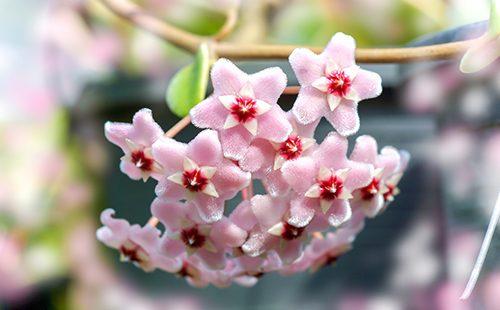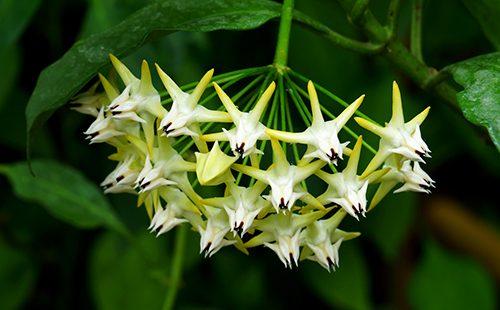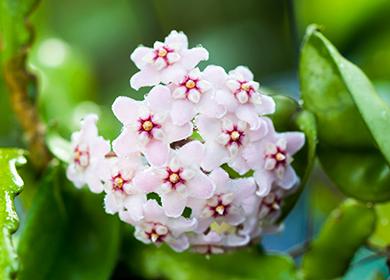The content of the article
Hoya has unusual flowers - thick, dense, fleshy, as if molded from wax. For this, the liana was called wax ivy. In a room culture, several varieties of plants are grown, some of which were obtained artificially as a result of selection work.
What looks and features
Most varieties of Hoya are beautiful vines, but shrubs and epiphytic plants are found in the genus. Shoots are lignified or grassy. Leaves vary by variety. They are dense, like wax, thin, elongated, needle-shaped. The color of leaves in most species is dark green, less often - variegated.
Star-shaped, five-petalled flowers, collected in umbrella-shaped inflorescences. The color is different - there are species with pink, red, purple, green, two-tone flowers. Petals are dense, smooth or pubescent. The number of flowers in one umbrella reaches 55 pieces.
Flowering lasts a long time - up to several weeks. Sticky transparent drops often stand out on the petals. Flowering occurs in the spring-summer period. With good care, hoya (wax ivy) can bloom repeatedly - in the fall. Some species bloom in the first year of life, others do not bloom for several years.
Species and varieties
Most species of hoya grows in China, India, Australia, Malaysia. Not so long ago, the number of indoor varieties was limited to a meaty and beautiful hoya. Now more species have been adapted for indoor cultivation; interesting hybrid varieties are found. The most common are six varieties.
- Meaty hoya. Creeper evergreen plant. With good care, the vines reach a length of six meters. Scented white-pink waxy flowers gather in an umbrella-shaped rosette. The foliage is dense, covered with a waxy coating.
- Hoya bella. Shrub with long, branched, drooping shoots. Used as an ampel culture. The leaves are small, ovate-lanceolate, densely cover the stems. The flowers are small, star-shaped, white, with a purple crown. Inflorescences are small - consist of seven to nine flowers.
- Hoya multi-flowered. Liana with curly shoots. The leaves are oblong. The petals are narrow, on the crown there are characteristic arched spurs. Coloring - different shades of yellow.
- Majestic hoya. Leaves are oblong, leathery. Petioles and shoots with a slight pubescence. An umbrella-shaped inflorescence includes up to ten fragrant flowers of red-yellow color.
- Concave Hoya (lactose). Ampel variety, forms a large number of cascading vines. The leaves are diamond-shaped, the flowers are white, densely pubescent. In nature is an epiphyte.
- Hoya Kerry. It differs in the original heart-shaped leaves, for which it received the name "Valentine". The leaves are succulent, rather large. Spherical umbrella inflorescences consist of 15–25 pubescent flowers. The color changes depending on the light intensity - different shades of yellow and pink appear. With age, the color of the flowers changes due to dark nectar - first they turn pink, then they turn red-brown.
Hoya care and creating a favorable microclimate
How to care for a hoya flower to achieve regular, lush flowering? The main requirement for the florist is to create a favorable microclimate in the apartment, full lighting and systematic watering.
- Lighting. Hoya is sensitive to lighting levels. At any time of the year she needs a bright, but not directional light. They shade from the sun in hot weather, but do not put it in the shade. The optimal location in the apartment is east and west windows. It can grow on the south window, but only with the protection of thin tulle.
- Temperature. It fully develops at medium room temperature, is not afraid of short-term heat. The most favorable temperature is 18-20 ° C. There is no pronounced period of rest; hoya can grow all year under favorable conditions. For abundant flowering, an forced dormancy period is arranged - from November to February they keep the liana at a temperature of about 15 ° C. The room is regularly ventilated. Wax ivy is protected from drafts; in summer they cannot be taken outside.
- Watering. Hoya should be watered sparingly, waiting for the topsoil to dry out. The soil should be slightly moist - waterlogging and stagnation of water lead to rot. Since mid-autumn, watering has been reduced, but the soil is not completely dry.
- Humidity. Wax ivy looks better with high humidity. Special measures to increase it are not required, it is enough to spray the leaves regularly. For spraying use soft, warm water, avoid droplets falling on the flowers. Periodically wipe the leaves from dust with a soft cloth or sponge. In summer, in warm weather, small specimens are watered from the shower.
- Top dressing. Does not need a lot of nutrients. They are fed once a month, adhering to the dosage indicated in the instructions. Fertilizer is allowed every two weeks, but in half concentration. From mid-autumn, feeding is stopped. In February, you can carefully feed the hoya, after moistening the soil. Use complex mineral preparations.
- The soil. The soil for hoya is chosen nutritious, light, permeable, with neutral acidity. Use universal finished soils with the addition of sand or perlite. With self-preparation, the composition includes sod, humus, peat, sand and deciduous land. Experienced growers practice hydroponic cultivation of hoya.
- Transfer. The frequency of transplantation depends on the age of the plant. Young wax ivy is transplanted annually, each time slightly increasing the diameter of the pot. With age, growth slows down, the frequency of transplants is reduced to once every two to three years. Transplanted in the spring, immediately establish support.
Breeding methods
Hoya propagates by seed and vegetatively. The first method is more often used to grow a new hybrid variety from store seeds.Vegetative propagation is widely practiced by gardeners to rejuvenate old bushes.
Cuttings
The easiest way is to propagate the hoya with cuttings. You can use apical and stem cuttings. The cultivation of new plants is carried out in the following sequence.
- Cutting cuttings. Apical and stem cuttings about 10 cm long are cut. Each segment should have a pair of leaves and two nodes.
- Training. Water is poured into a glass, an activated carbon tablet is added to it. A cut of the cut is dipped in a solution of the root stimulant. A small amount of rooting agent can be added directly to the water.
- Rooting. The cuttings are installed in a glass so that water covers the lower node. Maintain high humidity, temperature at the level of 20-22 ° С. The glass is covered with a bag. Hoya can be rooted in peat or sand, but the result will have to wait longer.
- Landing. Cuttings are transplanted into the soil immediately after the appearance of the first roots. You should not wait until they grow up - the roots are fragile, they easily break when planting.
Seeds
Only fresh seeds will sprout together, so be sure to check the expiration date at the store. Maximum germination is observed in the first year after harvest, then gradually decreases. To seedlings grow strong, when planting, adhere to the following sequence of actions.
- Seed and soil preparation. Seeds are soaked for ten minutes in a weak solution of growth stimulant, dried. Prepare the soil - mix garden soil and cut sphagnum. Low containers fill the substrate, level and moisturize it.
- Sowing. The dried up seeds are evenly distributed on the surface, sprinkled on top with a substrate. The container is tightened with cling film.
- Care. Germinate seeds at a temperature of 20-22 ° C. They are kept in a lighted place, daily, for ten minutes they raise the edge of the film for ventilation. Shoots appear quickly - within a week.
- Pick. Seedlings can be planted in separate pots in two to three months from the moment of planting, when they will release some real leaves. Too small shoots do not need to be disturbed - they can die during transplantation.

Common florist errors
Unsuitable conditions of detention lead to a decrease in the decorativeness of vines. Sometimes it is difficult to determine the cause of yellowing, lethargy of leaves, lack of flowering. A table will help to understand the mistake made and find a way to help the plant.
Table - Errors of gardeners when growing hoya
| A problem | Possible reasons | Help the plant |
|---|---|---|
| Yellow spots appear on the leaves | Direct sunlight, burn | On the south window shade from the midday sun |
| Hoya leaves fall | - Prolonged drying of the soil; - waterlogging combined with cold | - Normalize watering mode; - adjust the conditions of detention |
| Wax ivy turns yellow, wilts | - Low humidity; - defeat by pests; - prolonged heat; - decay of the root system | - Inspect for pests; - improve the conditions of detention; - if rot is suspected, they are transplanted by trimming damaged roots |
| Leaves turn pale, hoya grows slowly | Nutrient deficiency | - Transplanted into a new, nutritious soil; - regularly make balanced fertilizer |
| Leaves wrinkle, dry out | - Subcooling; - watering with cold water | - Rearrange in a warm place; - water for irrigation is kept at room temperature for 24 hours |
| The ends of the leaves are dry | - low humidity; - heat | More often sprayed |
| Buds fall | - Rearrangement of the pot; - a sharp change in conditions of detention; - low humidity | At the stage of bud formation and flowering, they try not to disturb the plant |
| Wax ivy does not bloom | - Poor lighting; - a large pot; - lack of nutrition; - warm wintering; - pruning pruning | - Eliminate mistakes; - arrange a rest period |
Dangerous pests
When growing hoya, you often have to deal with common pests of indoor flowers. You can avoid insect attacks by prophylaxis - spraying the plants with a weak solution of insecticide. If insects have already settled on a flower, a table will help you find them and find the best way to fight.
Table - Hoya Pests
| Pest name | Signs of defeat | Ways to fight |
|---|---|---|
| Spider mite | - Small yellow specks appear on the foliage; - the leaves dry, fall off; - shoots are covered with a thin web | - Small specimens are bathed under a warm shower, covered with polyethylene for a day; - adult bushes are sprayed with Aktara solution; - increase humidity |
| Shield | - On young shoots sticky drops appear; - dense plaques form; - leaves turn yellow, fall off, the plant withers | - Hoya is sprayed from a spray bottle with a weak alcohol solution; - adult insects are collected manually; - treated with Actellic or any other insecticide |
| Mealybug | - Petioles of leaves are covered with a waxy whitish bloom; - a substance resembling cotton wool is formed in the sinuses of the leaves; - growth is inhibited, leaves wither | - Small specimens are bathed in the shower with potash or laundry soap; - sprayed with Fitoverm, Inta-vir |
| Root nematodes | - Hoya stops growing, withers; - when transplanting on the roots, bloating is detected | - The plant is removed from the pot, completely remove the old soil; - the roots are washed in warm water (50 ° C); - treat the root system with an insecticide; - planted in sterile soil |
| Whitefly | - The leaves form round spots of small size; - gradually the leaves turn brown and fall | - Against adult insects, "Dichlorvos", "Raptor" are sprayed, sticky traps are hung; - against larvae, they are repeatedly treated with any insecticides |
| Fools | - Eroded areas resembling ulcers appear on the leaves; - Hoya grows poorly, turns yellow | - Several times, at weekly intervals, treated with an insecticide |

Frequent diseases
With good care, the hoya is rarely affected by disease. But the potential danger for it is fungal, viral, bacterial diseases. Treatment is started at the earliest stages to minimize the effects.
Fungal
Most often, hoya suffers from fungal diseases. Provoking factors - lack of drainage, dense soil, systematic waterlogging, lack of fresh air, combination of dampness and cold. You can recognize a fungal infection by the signs indicated in the table.
Table - Hoya Fungal Disease
| Disease | Signs | Treatment |
|---|---|---|
| Fomoz | - Appears bleached drying spots with dots of dark color; - leaves fall | - Water the soil with a solution of "Fundazole"; - sprayed with Hom or any medium containing copper |
| Soot fungus | - A black dry film appears in the places of the paddy (pest secretions); - the plant stops growing, weakens | - Wipe the affected area with a soapy sponge; - sprayed with systemic fungicide |
| Root and stem rot | - Wax ivy stops growing; - the leaves become lethargic; - the root system rots | - Heavily damaged specimens are destroyed; - at the beginning of the disease treated with Bordeaux fluid |
| Powdery mildew | - Loose powdery spots appear; - as the disease progresses, plaque spreads rapidly | - Cut sick branches; - improve care and conditions; - sprayed with "Topaz", "Tiovitom" |
| Downy mildew | - Smudged yellow spots appear; - dark spots are visible on the back of the sheet plate | - Cut off the diseased parts of the plant; - processed by "Hom", "Ordan" |
| Anthracnose | - Rounded spots appear with a distinct outline and a dot in the center; - gradually the spots grow, a hole forms in the middle | - Cut infected leaves; - sprayed with "Quadrice", "Home" |
| Alternariosis | - The lower leaves are covered with brown dry spots; - gradually the spots become larger, blacken | - Cut the infected leaves; - reduce humidity; - sprayed with preparations containing copper: "Cupricol", copper sulfate |
| Rust | - There are spots of red or orange rusty color; - convex growths form on the back of the diseased leaves | - Break off diseased leaves; - sprayed with "Topaz", "Vectra" |
| Ascochitosis | - Small reddish spots of rounded shape are formed; - over time, the lesion sites grow, darken, a bright spot with black spots forms in the center | Treat as anthracnose |
| Phyllosticosis | - Purple dots appear; - gradually the areas increase, become irregular in shape | Treat as anthracnose |
| Black spotting | Convex shiny dark spots appear | Sprayed with copper chloride |
| Cortical outgrowth | - The surface of the tarnished foliage is covered with a grayish coating; - on the reverse side a plaque is formed; - sick vines do not grow | - Hoyu wiped with alcohol; - sprayed with “Hom”, “Ordan”; - keep in a warm place with additional lighting |
| Verticillus wilting | - The lower leaves become grayish; - separate shoots die off | - At an early stage of the disease, they are sprayed with Fundazol, Topsin; - heavily damaged plants destroy |
Bacterial
Hoya bacterial diseases are usually more difficult to diagnose. By symptoms, they can resemble the manifestations of a fungus. The table describes diseases of bacterial origin that are dangerous for hoya.
Table - Hoya Bacterial Diseases
| Disease | Symptoms | Treatment |
|---|---|---|
| Bacterial rot | - Fabrics soften, emit an unpleasant odor; - the spread of rot begins from any part of the bush | - In the early stages of the disease, the plant is isolated, kept dry; - all affected shoots are removed with a portion of healthy tissue; - sprayed with Bordeaux liquid, preparations containing copper; - watered and sprayed with a diluted antibiotic |
| Bacterial wilt | - The leaves become lethargic, flabby; - the tops of the shoots wither; - gradually fades the whole bush |
|
| Bacterial spotting | - Spots with a vague contour are formed; - the affected area increases, leading to the death of the leaf |
Viral
When the first signs appear, flower growers confuse viral diseases with a lack of nutrition or chlorosis. The first external sign is a slowdown in growth. The remaining symptoms are described in the table.
Table - Hoya Viral Diseases
| Disease | Symptoms | Treatment |
|---|---|---|
| Mosaic disease | - Yellowish stripes and spots of various shapes form; - the flowers are covered with dark spots; - leaves are deformed | - Carry out pruning to healthy tissues; - examine the hoya for pests; - chemicals do not use - they have no action against viruses; - in most cases, diseased plants destroy |
| Leaf curl | - There are many point, gradually drying out spots; - the leaves are curled; - flowers lose their shape |
|
| Yellowing leaves | - Foliage acquires a yellow tint; - individual lashes stop growing, easily break |
Chlorosis is distinguished into a separate category.It is characterized by a violation of the production of chlorophyll. As a result, the leaves become pale, turn yellow, become stained. Chlorosis is treated by the introduction of complex fertilizers, by spraying with preparations containing copper.
Properly organized care for wax ivy at home minimizes the likelihood of illness. In a favorable environment, the liana grows rapidly, blooms profusely.

